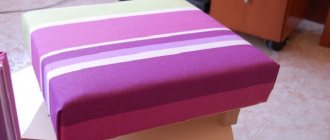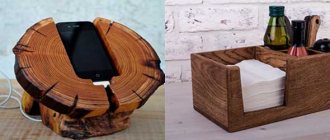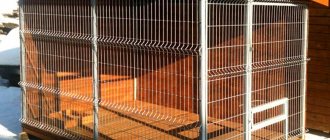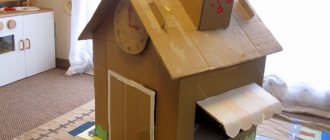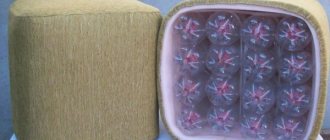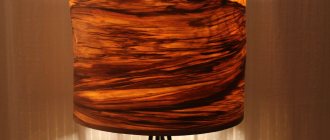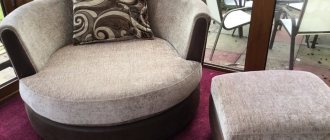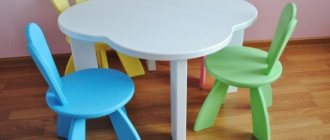A soft, comfortable and original handmade ottoman will not leave anyone indifferent. It is comfortable to sit, looks beautiful, and fits perfectly into the design of any room. It is made from materials that are available in every home, which plays an important role when calculating its cost. You can name a large number of advantages of such ottomans. But the main thing is your work, which will give you pleasure. A wide variety of ottomans made from scrap materials makes you think about choosing an option.
How to make an ottoman from chipboard with a lid?
A cube-shaped pouf with your own hands can be placed in the living room or nursery.
The photo shows a bright opening ottoman made of chipboard, which acts as a seat and storage place for various small items.
Materials and tools
To work we need:
- Chipboard sheet.
- Wooden blocks (4 pieces) 4x4x37 cm.
- Piano loop.
- Furniture swivel casters.
- Thick foam rubber 40x40x10 cm.
- Sintepon 45x160 cm.
- Strong fabric material for upholstering the base 55x165 cm.
- Cover material 65x65 cm.
- Electric jigsaw.
- Screwdriver.
- Furniture stapler.
- Self-tapping screws.
- Universal and wood glue.
Instructions
Let's get started:
- We cut out the blanks according to the following dimensions: the front and back walls are 40x37 cm, two side walls are 37x37 cm, the bottom of the base is 40x40 cm. We assemble the cube using 4x4 cm bars using glue.
- When the glue dries, we additionally reinforce the bars with self-tapping screws. This will make the foundation stronger. Use the same method to fix the lower part.
- We wrap the side walls with padding polyester, securing them with a stapler. At one of the corners we attach the upholstery fabric with an overlap, tucking the cut inward and leaving an allowance of about 2 cm. We bend the allowances inside and to the bottom of the pouffe using a stapler.
- We glue the square of foam rubber onto the lid blank using glue.
- We wrap the lid with fabric, folding the edges and securing it with a stapler from below.
- Using self-tapping screws, we fix the lid to the wall with a hinge. We attach wheels to the bottom of the finished product. Your DIY ottoman is ready!
You can watch a detailed video about making a rectangular ottoman yourself here:
Bottles are divided into two parts
One part of the bottles is covered with masking tape, approximately to a height of 1/3 from the neck. Then the bottle is cut in the middle of the masking tape. The neck is inserted inside the cut part with the lid down.
Next, the whole bottle is inserted inside the cut one, that is, the neck of the whole bottle is inserted inside the cut neck. The bottles are fixed to each other with transparent tape.
Arrange 4 bottles and align them in height. Then you need to secure such a structure with tape, wrapping it tightly along the entire length.
Having collected the required number of elements, each of which consists of 4 bottles, wrap the resulting cube with tape along the contour at the top and bottom.
Measure the size of the sides, or easier, place each side on a piece of fabric and outline the contours. Increase the seams and foam thickness - 2 cm on each side will be enough.
The desire for changes and renovation of the interior can be realized through the use of new pieces of furniture that will enrich the design. It’s very easy to make a beautiful and original ottoman with your own hands, and there is always a place for it in the living room, cozy bedroom or children’s room, or hallway.
Poufs come in different shapes and sizes, their design is as simple as possible and therefore even a novice craftsman can make such a design. Moreover, such pieces of furniture have quite interesting features and a wide range of applications, so making them will be an exciting activity.
Cardboard pouf
An unusual, but stylish and budget-friendly ottoman made from recycled materials is suitable for a summer house, as well as for an informal interior, such as a loft.
The photo shows an ottoman, which can be easily made without drawings from ordinary cardboard packaging.
Materials and tools
To create a pouf with your own hands you will need:
- Carton boxes.
- Flat pillow.
- 6 m of strong braid, about 40 cm wide.
- 6 connecting rings.
- Roulette.
- Cutter.
- Scissors.
- Threads with a needle.
Instructions
Let's start making:
- Based on the area of the pillow, we determine the dimensions of the base (for example, 40x40 cm).
- Stack all the boxes until you get a base of the desired height. You can help yourself with a cutter, pressing the cardboard along the fold line, but without cutting.
- Cut the braid into 3 equal parts. We take one strip, thread 2 rings, sew up the edge.
- We do the same with the other two strips.
- Under the cardboards stacked on top of each other we thread 2 belts parallel to each other. We tighten the structure with straps and secure it to the side. We also fix the third belt on the narrow side. We put a pillow on top. The eco-friendly pouf is ready!
Design features
According to their design features, poufs are transformable . That is, with the help of special mechanisms, they turn into:
A folding bed. Such models can be put forward according to different principles. A folding pouf is suitable for both small and spacious apartments. It will not be possible to completely replace the sleeping place with it .
But it will be useful if you suddenly have overnight guests. During the day, such a piece of furniture is used as a seat; at night, it can replace a bed for one person.- Armchair. When unfolded, the pouf will be no different from a comfortable and functional chair. It will harmoniously fit into the surrounding environment and become a beautiful decor for any room.
- Coffee table with two seats. Such a piece of furniture will help comfortably accommodate two people for tea, a board game or for pleasant communication.
How to sew a soft round pouf?
An original patchwork ottoman will add even more warmth and comfort to your home. It is made from leftover fabric that everyone has.
The photo shows a DIY patchwork style ottoman.
Consumables
To sew such a pouf, you will need:
- Scraps of multi-colored fabrics.
- Fabric for the back of the ottoman.
- Rope.
- Filler.
- Button.
- Pins
- Scissors
- Ruler and pencil.
- Sewing machine.
Step by step guide
Let's get started:
- Cut out identical rectangles measuring 5x30 cm.
- Divide the rectangles into triangles: draw a line diagonally from one corner to the other and cut.
- We lay out the resulting triangles, alternating them by color and pattern. We sew on a machine until we get a circle of scraps.
- We cut out a circle of the same size from a single piece of fabric - this will be the back of the pouf. We hide the rope inside the pillowcase, secure it with pins and machine connect the fabric as close to the rope as possible.
- Leave a small hole to turn the workpiece inside out.
- We sew the edges of the rope and hide them with a hidden seam.
- We stuff the ottoman tightly with filling and fix the decorative button in the middle, stitching it right through.
- The pouf is ready with your own hands:
Making an ottoman from a bucket
If a plastic bucket has become unusable, you can turn it into a cute ottoman:
The photo shows a do-it-yourself ottoman that fits perfectly into country or eco-style.
What do you need?
To work you need the following tools:
- Plastic bucket.
- Jute rope.
- Textile.
- Filler.
- Decorative button.
- Scissors.
- Hot glue gun.
- Furniture stapler.
- .Velcro tape.
Manufacturing instructions
Let's start creating an ottoman with our own hands according to the following scheme:
- Remove the handle from the bucket.
- We cover the surface of the bucket with jute rope, fixing it with hot glue.
- We cut out two parts along the circumference of the bottom: one from thick cardboard, and the other from fabric, but 10 cm larger.
- We connect the circles with a button, stuff them with soft filling and fix the fabric sheet on the cardboard base using a stapler.
- We secure the seat to the bottom of the bucket with Velcro tape.
Learn more about transforming an old bucket into a vintage ottoman with your own hands in this video:
Children's ottoman for toys
A very stable and practical ottoman for storing cars and dolls is made from two wooden boxes.
The photo shows a comfortable and eco-friendly pouf with a hinged lid.
What do you need?
Necessary materials:
- Two wooden boxes.
- Chipboard sheet for the lid.
- Jigsaw.
- Foam as a filler.
- Fasteners, screws, screwdriver.
- Burlap or any other dense fabric of bright colors.
- Glue.
- Stapler.
Manufacturing stages
Let's start assembling the ottoman with our own hands:
- We fix two drawers along the long sides with self-tapping screws.
- Using a jigsaw or hacksaw, we cut out the lid to the size of the two connected boxes.
- At the next stage, glue foam or foam rubber onto it.
- We sew a cover for the lid from thick fabric material.
- You can take a simpler route: stretch the fabric and secure it with a stapler.
- Using self-tapping screws, attach the lid to the piano hinge.
- If desired, the finished pouf can be painted, and to make it mobile, furniture legs can be screwed on.
Materials and tools for work
If you decide to make a pouf yourself, then before doing so, carefully consider what materials it will be made of. For the covers themselves, only durable, high-quality, practical materials are used, among which are:
- Velours. It has a soft, silky texture and a variety of colors. The fabric is quite capricious when caring for it, i.e. Dirt stains are difficult to remove from it, so it is better not to use it on poufs intended for children's rooms or the kitchen.
- Furniture cotton. Convenient to use because resistant to various types of stains, easy to wash, and does not fade.
- Jacquard. Beautiful, dense, quite durable fabric. It is easy to clean and does not lose color during washing.
- Flock. Quite soft material, resistant to various types of pollution, does not deform.
- Microflora. The material has a wide color palette. It is quite durable and easy to use.
- Leatherette. The most popular material, valued for its practicality and excellent performance characteristics. However, it does have one drawback - susceptibility to scratches. If there are pets or small children in the house, then it is better to refuse this option.
- Genuine Leather. This type of material has no disadvantages, except for its high price.
A variety of materials are used for filler:
- polystyrene foam balls;
- foam;
- rubber sawdust;
- paper;
- padding polyester
The most important thing to consider when choosing a filler is that it is environmentally friendly, safe and durable.
To create a masterpiece with your own hands, you will need the following tools:
- sewing machine;
- material for the cover and gasket;
- filler;
- threads;
- scissors;
- pattern paper;
- decor
Stylish pouf made from old jeans
Sometimes original furniture can be made “out of nothing” and turn several unnecessary things into one useful one.
The photo shows a strong pouf made from old jeans, which can serve as a seat, table or footstool.
Consumables
To work you will need:
- 25 identical plastic bottles.
- Double sided tape.
- Remains of plywood or thick cardboard.
- Foam rubber.
- Old jeans.
- Thread and needle.
- Sewing machine.
Step by step guide
Let's get started:
- We wrap the central bottle with tape and attach 5 more containers to it. Wrap it with tape again. Using this template we build up the frame of the ottoman.
- From cardboard or plywood we cut out two identical circles along the diameter of the connected bottles.
- We level the structure and secure the circles tightly to the base with tape.
- We wrap the frame with foam rubber: first the side, then the lid. We sew the foam rubber with threads.
- We sew a cover. To do this, carefully take measurements from the resulting ottoman and transfer it to paper. Using the pattern, we cut out the details from denim fabric, leaving 2.5 cm for allowances. We sew them together.
- A round seat can be made using the patchwork technique, so the pouf will look even more interesting. There are two ways to secure the material at the bottom: sew on an elastic band or secure with a stapler. The decor of the ottoman depends only on your imagination.
You can see how to make an ottoman out of bottles with your own hands in this video:
Square ottoman
This neat homemade ottoman doubles as an ottoman or pillow and is very easy to make.
The photo shows a frameless square ottoman, made by yourself.
Materials and tools
To make it you will need:
- Thick fabric.
- Sackcloth.
- Pillow filled with polyfoam styrene.
- Pins, scissors, sewing machine and thread.
The photo shows a kit for making an ottoman.
Master class on making
Let's get started:
- The size of the ottoman depends on the pillow. We cut out the necessary elements from thick fabric: one square (this will be the top) and four rectangular (for the sides).
- We cut out another piece from burlap and connect all the elements with pins.
- We sew together all the parts except one and turn them inside out.
- We place the pillow inside and manually sew the product. A comfortable frameless pouf, made by yourself, is ready.
What fabric to choose for frameless furniture
The bean bag chair consists of two covers. The inner one should be formed from breathable, durable materials. For the exterior, you need to choose an attractive, yet highly durable, easy to clean, abrasion-resistant fabric. The optimal choice is Oxford material, which is used to make tents. It has a special impregnation that makes it waterproof. Thanks to this, poufs made from this fabric can be used outdoors. The canvas is presented in a wide range of colors, so you can choose the appropriate option for any interior.
Another material option for the outer cover is eco-leather. It is also waterproof and equally easy to care for.
If the ottoman will be used only at home, you can use other dense fabrics - corduroy or tapestry. However, such a cover will need to be removed for washing, so you will need to install a zipper.
Making a homemade ottoman is not at all difficult. Choose the model you like and realize your idea.
Ottoman from a stool
If an old stool has become unusable, do not throw it away - it will become an excellent basis for a unique ottoman.
The photo shows an elegant pouf made from an antique round stool.
What is needed for production?
Materials and tools:
- Old stool.
- Sandpaper.
- Primer, paint for furniture.
- Foam rubber.
- Elastic fabric material for upholstery.
- Construction stapler.
Management
Let's get started:
- We sand the old stool with sandpaper to remove the varnish. We prime and paint.
- After drying, cut out the foam and secure it with a stapler.
- Using the same method, we fix any suitable fabric.
Another way to turn old furniture into an ottoman is in this video:
A do-it-yourself ottoman made from scrap materials is not only a multifunctional interior decoration, but also a great way to save your family budget.
